This post is a guide to riding Lisbon's Tram 28E.
We cover ticket prices, schedules, tips on how to avoid the crowds, and a map and description of notable stops you might want to visit.
Riding a tram in Lisbon, such as Tram 28, is so popular that we start and end our walking tours at tram stops because they are so easy to use!
On every one of our tours, our local tour guides are asked by guests how to ride the streetcars in Lisbon.
We have relied on our experience riding the tram to create this post and to help you plan your journey.
We also included tips and suggestions from members of various Lisbon Travel Facebook groups and you can read these comments at the bottom of this post.
- Overview
- Tickets + Schedule
- Beat the Crowds
- Route Map + Stops
- Lisbon Public Transit Guide
- Things to Do in Lisbon
OVERVIEW
The secret is out when it comes to Tram 28, as this has become arguably the most popular tram in all of Lisbon thanks to all the landmarks and sites you can see along the way.
Due to Lisbon's narrow streets and steep hills are steep and narrow, modern trams can’t be used on most routes.
Instead, many Lisbon trams are vintage, 1930s, Remodelado trams, such as Tram 28E.
The old-time ringing and the hard, uncomfortable wood benches add to the charming ambiance of these historic trams.
Here are just a few of the locations you can reach with ease using this service:
- Se Cathedral (Lisbon Cathedral)
- Thieves Market
- São Jorge Castle
- Basilica da Estrela
- National Pantheon
- Miradouro da Graça
- Arco da Rua Augusta
- Assembly of the Republic
- Museum of Decorative Arts
- Miradouro das Portas do Sol
- And more!
We’ll cover even more of the landmarks and tourist attractions included along the way in our section about the route map and stops you may want to make.
Tickets are very affordable, but you can save more money on them using either a Viva Viagem card or a Lisbon tourist pass.
We’ll cover all admission options in our tickets & schedule section.
This tram is available every day of the week, with the first departure at just before 6 am, and the last departure shortly after 11 pm on weekdays and at 10:30 pm on weekends.
It’s very popular, so you should expect standing-room-only most of the time and there might not be any room at all during peak hours and busy tourist seasons.
The historic Remodelado Tram 28E
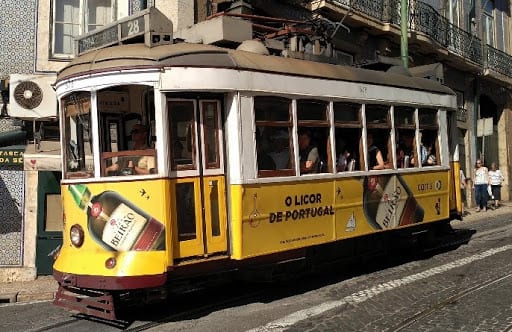
If you want help figuring out how to avoid missing the tram, make sure to read our section offering tips and tricks to beat the crowds.
TICKETS AND SCHEDULE
All trams in Lisbon are part of the public transportation system, which means that ticket prices will be the same for each of them.
Here are the fares you can expect to pay:
- Single Ride purchased on the tram: €3 (€1.50 with Viva Viagem card)
- 1-Day Ticket: €6.45 (available with Viva Viagem card)
As you can see, the Viva Viagem card cuts the price in half for single rides, and it can also be used to purchase 1-day tickets.
This travel pass costs just €0.50 to purchase, so even if you only use it for one ride, you’ll still save €1 using this service.
However, you can’t pick up the Viva Viagem card from tram conductors. Conductors only accept cash for full-priced tickets.
Viva Viagem cards are available at any Metro station and suburban train stations, on ferries, and at PayShop locations.
For more details about Viva Viagem and other ways to save money on trams, please read our post covering public transportation in Lisbon.
Tickets and Viva Viagem cards are valid for all forms of public transport in Lisbon, including trams, metro, buses, and funiculars.
TIME-SAVING TIP
If you want to avoid any confusion with getting tickets, consider getting a Lisbon Card instead.
This tourist pass includes unlimited free travel on all metro, buses, elevators, and trams -- including Tram 28!
You can also use this pass for free entry to dozens of museums and monuments, train travel to Sintra and Cascais, and additional discounts at popular restaurants and shopping centers (learn more here).
Prices start at just €21 a day, so if you're planning to see and do a lot while in Lisbon, this could be a good way to save money and time without worrying about whether or not you have the right tram tickets.
Tram 28 Schedule
- Starts at Martim Moniz
- Ends at Campo Ourique
- Weekday Hours: 5:40 am - 11:30 pm
- Saturdays: 5:45 am - 10:30 pm
- Sundays and holidays: 6:45 am - 10:30 pm
Trams run every 10 minutes during rush hour and every 15 minutes for off-peak hours.

Taking Tram 28 from one end to the other will last approximately 48 minutes depending on traffic.
Check the official website for the current timetable.
TIPS TO BEAT THE CROWDS
Due to its popularity, Tram 28 often offers only standing room most of the day.
The tram can seat only 20 or so passengers, with standing room for about 30 passengers.
And conductors often skip stops when there is no more space for additional passengers, much to the annoyance of locals.
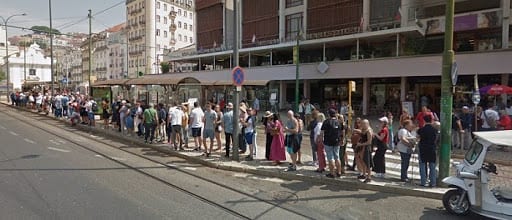
Likewise, queues at the tram departure points – particularly at Praça Martin Moniz – can take an hour or more, particularly in the busy cruise-ship season (see image above).
Here are a few tips to help you avoid crowds.
1. Go Early or Late
Visitors using the tram early in the day (6 am - 8 am) can expect smaller than usual crowds on Tram 28.
It’s also usually a lot less busy at the end of the night 21:00 - 23:50 (9 pm - 11:30 pm).
2. Start at the Opposite End
A lot of travelers hop on Tram 28 at its point of inception, Martim Moniz, but it has 2 starting points.
By the time it reaches its final destination at Campo de Ourique (map), most people have hopped off at one of the many attractions along the way.
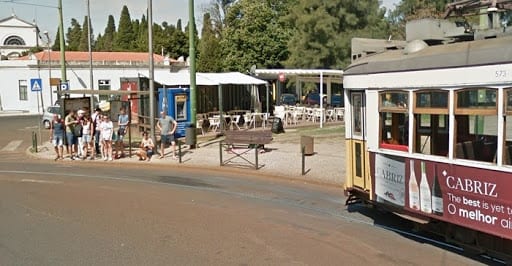
You are much more likely to get a seat here, as you can see in the image above of a small crowd waiting for an empty tram.
You can also use Tram 25E or several public bus lines to reach this location.
This end is also where you can find Jardim da Estrela, Basilica Estrella, and the Prazeres Cemetery, so you can make it a well-planned adventure.
3. Consider an Alternative
While Tram 28E is a great way to see some of the best landmarks in Lisbon, it’s not the only service that operates with Remodelado trams.
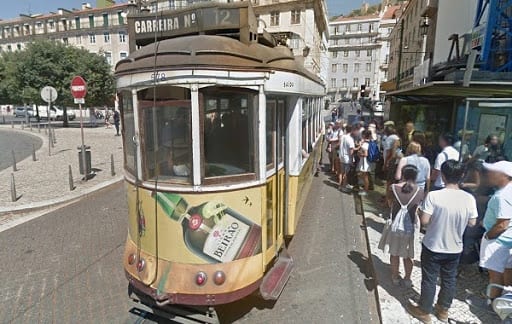
The 12E tram runs along some of the same tracks in Alfama as the 28E, including stops at the São Jorge Castle, Miradouro de Santa Luzia, the Se Cathedral, and more.
It stops at Praca Figueroa, one stop before Montim Moriz, so you should have a better chance at getting a seat.
The lines for the 12E at Martim Moriz are usually shorter than the line for the 28E, so it’s an option for you if you don’t want to wait for the latter.
You may also want to use the 25E tram to reach Campo Ourique, where you can start your journey back to the downtown area on the 28E.

There’s also a tram specifically designed for tourists owned and operated by Yellow Bus Tours (though their trams are red).
Many travelers report this is an excellent option, and you can even save money on their services using a tourist pass!
Lastly, if you think you’re up for it, you can always walk the route of Tram 28 to see all the sites included.
4. Watch Out For Pickpockets
This is just a general word of advice you should keep in mind, especially if you’re planning to board a very full tram.
There is a bit of a pickpocket problem in the city center of Lisbon, and many of them target this popular service.
Even if you just plan to walk the route, make sure to take the proper precautions so that you don’t get anything stolen.
TRAM 28E ROUTE MAP AND TOP STOPS
Tram 28 has a total of 34 stops, and while a lot of them are at or near historic landmarks, they aren’t all locations that tourists will want to visit.
The following map will give you a better understanding of where each notable site is located, and we will also provide details about some of the best stops along the route.
Click on the map to open a larger, interactive map.
Praça Martim Moniz
This is where the Tram 28 route begins, and it’s also a great location to visit.
There are several notable sites within walking distance, including the Church of São Domingos and Praça do Rossio.
R. Graça Miradouro da Senhora do Monte
Traveling north on the tram, this is the next stop you might want to make, as the excellent viewing point Miradouro da Senhora is nearby.
You’ll also find Jardim da Cerca da Graça, a wonderful park with a play area that also offers wonderful views of the city.
Graça – Viewpoint of Graça
The next stop you might want to consider is Graça, which is located right next to Convento de Nossa Senhora da Graça.
This is the site of Miradouro da Graça, another excellent viewing deck where you can get a good look at the rest of the city.
We also offer a self-guided tour of Alfama that begins from here to help you find the best places to visit, and it’s entirely free to use!
Voz Operário
Continuing south, you’ll come across this stop shortly after Graça, and there are many reasons to hop off here.

The Church of São Vicente of Fora is nearby, as is the National Pantheon.
You can also visit the Santa Clara Market, a flea market otherwise known as the Thieves Market which is open on Tuesdays and Saturdays.
Lg. Portas Sol & São Jorge Castle
As Tram 28 heads further south, you may want to stop here to enjoy one of the best views in the city at Miradouro das Portas do Sol.
This is also the closest stop to São Jorge Castle and the Museum of Decorative Arts.
TIP: If you're interested in visiting the castle, it's worth noting that you can get tickets to climb the Tower of São Jorge Castle for just €5.
Santa Luzia Viewpoint
Just a bit further south from Lg. Portas Sol, you’ll find yet another excellent viewing deck – Miradouro Santa Luzia.
Whether you’re looking for a different point of view (literally) or other viewpoints are crowded, this is a great stop to make.
Limoeiro
After traveling southwest from the last location, this stop is the next site you may want to consider visiting, as it’s within walking distance of Se Cathedral, the Roman Theatre, and the Church of Santo Antônio de Lisboa (Igreja de Santo António).
R. Conceição
Heading west from Se Cathedral, this is the next stop which includes some pretty popular attractions.
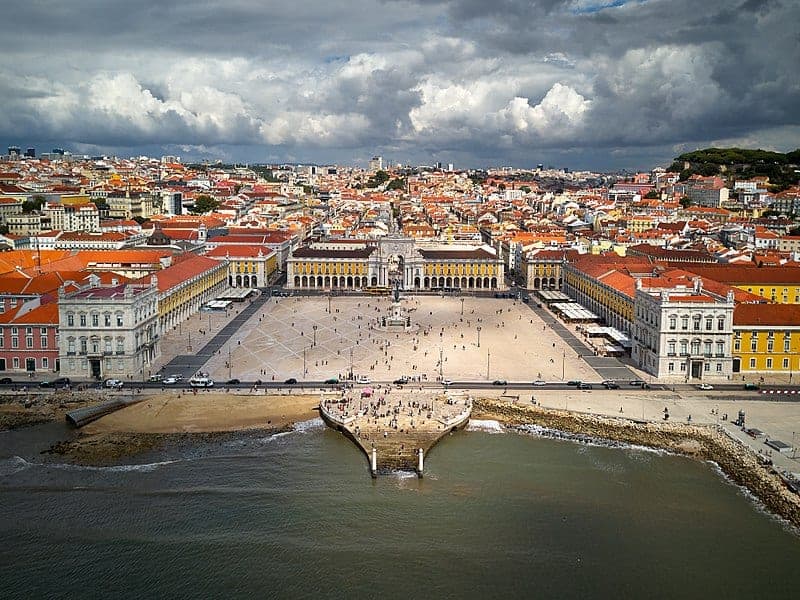
Located in the Baixa (low town), you’ll have the opportunity to visit Praça do Comercio, Arco da Rua Augusta, and MODA.
There is also a self-guided tour of this area which you can take for free!
Lg. Academia Nacional Belas Ar
If you’re interested in seeing the Cais do Sodre neighborhood, this is probably the best place to get off Tram 28 and take a look around.
It’s also a transfer point for trams 24E and 15E, the latter of which will take you to Belem.
Praça Luis Camões
Traveling north from Lg. Academia Nacional Belas Ar you’ll reach this next stop in Chiado.
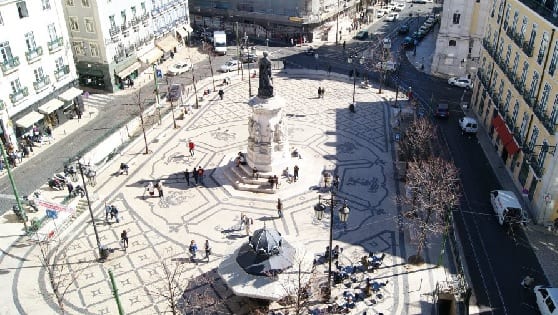
This neighborhood has several theatres for operas/musicals and venues for Fado music. It’s also a well-known commercial area with high-end shopping.
Located next to Bairro Alto (high town), this district is actually where both our self-guided and GPS-led audio tours begin.
This is also where free walking tours of the area start.
Calhariz
Just west of Praça Luis Camões, this stop is where our self-guided tour of Chiado-Barrio Alto begins, and it’s also the place where Elevador da Bica departs.
This stop is also just a few blocks from another viewpoint, Miradouro de Santa Catarina.
Cç. Estrela / R. Borges Carnei
This stop is further west from Calhariz and it’s right in front of the Portuguese Parliament Building.

Right next to it, you’ll also see the Assembly of the Republic and many other notable government buildings.
Across from the Assembly is the Jardim das Francesinhas/Jardim Lisboa Antiga.
Estrela (Basilica) - Jardim de Estrela Park
Heading northwest from the Parliament Building, the next big stop is going to be perfect for taking a break and enjoying a walk.
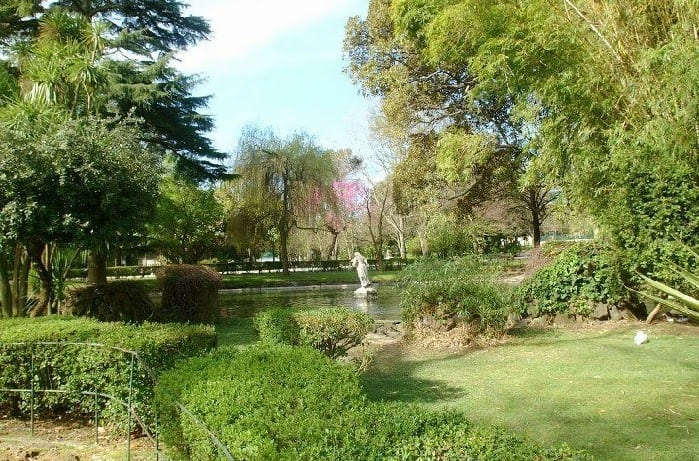
This is the site of not only the Basilica da Estrela but also the Jardim da Estrela. While you’re here, enjoy the views from this historic church!
Campo Ourique
This is the final stop on Tram 28 and it’s the site of a famous cemetery.
The Prazeres Cemetery has been the final resting place of several notable Portuguese people.
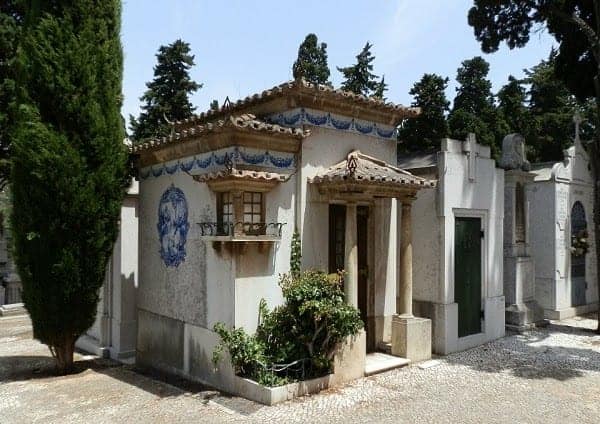
To name a few, Prime Ministers like Maria de Lourdes Pintasilgo, pianists like Alexandre Rey Colaço, painters like Columbano Bordalo Pinheiro, and former president Mário Soares, are buried here.
TIPS FROM LOCALS AND TRAVELERS
Here are some tips and suggestions from Lisbon Facebook groups like Lisbon Travel Tips and Travel Portugal Tips.
One question that comes up in many Lisbon travel tips Facebook groups is if riding Tram 28 is worth it.
You’ll see a split among opinions. Some comments, like the one below, say the ride is an excellent way to see the city while getting to locations you will want to see anyway.

This commenter agrees that it is worth taking to the extent that it will take you to places that may already be on your itinerary, it is jam-packed with tourists.

The fact that it can be very crowded is why some commenters say, that despite the tram itself being nice, they would rather have walked.

This commenter thinks riding Tram 28 is worth it -- but only if you get on it early.

We highly recommend getting there as early as possible. These riders suggest as early as 7:00-7:30, but definitely before 9 am.
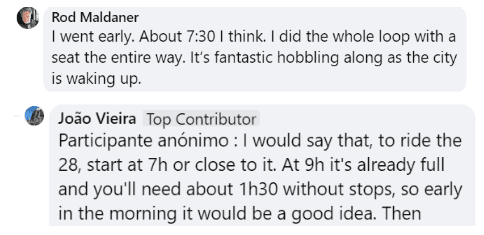
For those who cannot make it before the crowds, here are commenters with ideas similar to our tips in this post.
If you start at the opposite end of the line at the cemetery, rather than at Praça Martim Moniz, you'll have a better chance of getting a seat.
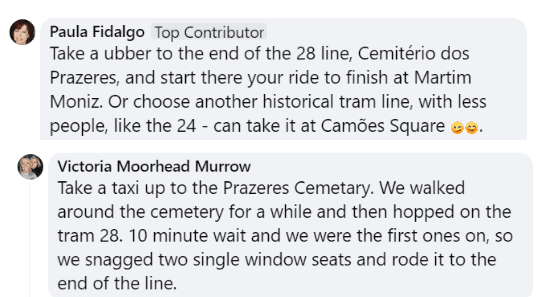
Another tip is to walk ahead of the first stop, walk up to the next stop, and hop on there.

The commenter points out that as riders disembark along the route, it’s worth a try to go to the second stop. It’s better to try than wait in line for hours!

Here is a very interesting alternative. great tip. Take Tram 12 part of the way, get off, have a rest and then get on Tram 28 as Tram 12 and 28 share a route for part of the way.

Or for that matter, stay on Tram 12. While it is a shorter route, it will be easier to get on.

A safety tip from both locals and travelers: watch out for pickpockets. You are a prime target in a crowded tram.

Should this concern stop you from taking Tram 28? No. Just stay aware, keep your bags close and by your side, don’t carry anything in your pockets, and you will have no problem.

RELATED POSTS






